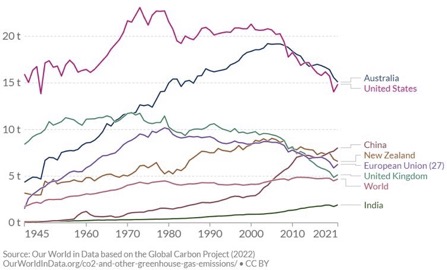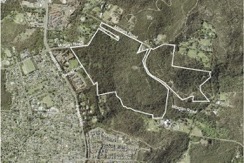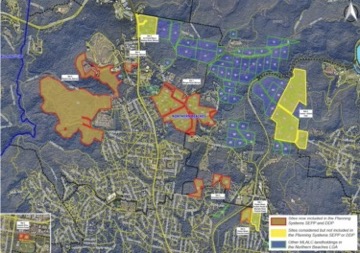
It’s called Frenchs Forest for a reason and why it is important to see the wood for the trees
From our ‘Thinking outside the box’ series
Rico Merkert and David Li look at the effectiveness and authenticity of carbon offsetting when looking at the true carbon footprint of proposals.
The recent record-breaking floods and the not-so-distant memories of 2019 bushfires still haunt many of us. Today, most have accepted the scientific consensus that we are at the dawn of a climate emergency. Amongst the many challenges surrounding us, controlling carbon emissions has proven to be the hardest job our modern society has ever witnessed. Living in the 'Lucky Country', it's easy for us to shift the attention away and blame others. Sadly, as our governments may often have us believe that we are doing everything we can to catch up, Australia is amongst the most carbon-intense economies in the world, at 15 tonnes per person per year (Figure 1), well ahead of most other advanced economies in the world. Yes, you heard it right. An average Australian emits more CO2 than an average American.

Figure 1. Per capita CO2 emissions by country; Source: Our World Data
Having the will is far from enough and we would be fooling ourselves to expect no changes to our way of life. Many sectors are starting to realise how entrenched we are in this fossil-fuel-powered modern life and how much hard work, investment, and compromise it's going to take to move the needle. The new federal government has recently announced to reduce Australia's emissions by 43% by 2030 1. In the coming years, significant and swift changes will be necessary in areas such as where we live, work, and find entertainment, how we power our homes, what we eat, and how we move around our communities, commute to work, and travel the world. We can also expect more severe weather events to serve as a reminder of the urgency of these changes.
All these changes are geared to achieve an outcome. From Canberra to community neighbourhoods, from corporate boardrooms to local school classrooms, we are in the era of decarbonisation.
And this has brought us to the inconvenient truth in the recent MLALC development proposal at Lizard Rock, Morgan Road, Belrose. Despite a comprehensive list of benefits that are "consistent with the planning guideline", this proposal comes at a cost of 51.1 hectares of deforestation, in an area covered with mature Bloodwood-scribbly gum, Narrow-leaved scribbly gum, Angophora woodland, coastal Banksia-Teatree scrub and Narrabeen Escarpment scrubs 2.
Whilst we are not arguing against the potential economic and social benefits, such as additional housing, and indigenous cultural preservation this proposal seeks to achieve, we simply want to bring the attention of our community and politicians to the cost of deforestation, which is 'conveniently' not explicitly covered in the proposal reports.
It is hard to believe that in 2023, as the Australian society are moving mountains to take carbon (emissions) out of our life without inducing harsh impacts, we could be considering the option to build new housing at the cost of deforestation. Yes, trees are nice, but this is not an argument about the importance of preserving a native bush surrounding to our beautiful Sydney. We are simply arguing against the proposal from a carbon-economic standpoint, and the benefits of letting the bush be (say for biodiversity or recreational benefits).
Without any corporate jargon, we want to help our community understand the negative carbon impact of the Belrose project. We do this by calculating the carbon offset cost and material cost, two common measures used in the science community.
First, let's look at the numbers. The proposal report stated a total area of 710 thousand square metres of native bush, of which 511 thousand square metres (72%) to be removed (Table 1). Figure 2 illustrates the area of concern.
Table 1. Lizard Rock proposal deforestation; Source: (GYDE, 2022) 3
Total area (sqm) |
710,007 |
Conservation under proposal (sqm) |
198,802 (28%) |
Estimated deforestation (sqm) |
511,205 (72%) |

Figure 2. Aerial view of site, outlined in white; Source: (GYDE, 2022)
We then plug the figures into the standard deforestation carbon conversion matrix (Table 2).
Table 2. Deforestation carbon conversion; Source: (IPCC, 2018) 4
Area of concern (hectares) |
IPCC |
CO2 emission per hectare of deforestation (tonnes) |
Average CO2 emissions in area of concern (tonnes) |
51.1 |
Temperate forest |
100-150 |
6,390 |
This gives us an estimation of 6,390 tonnes of CO2 emission. Whilst deforestation can be complex, we can interpret the result as such: the deforestation brought by the Belrose proposal would result in a surplus of 6,390 tonnes of CO2 being released into the atmosphere.
So, what does this mean? First, let's interpret this from a carbon offset standpoint. Suppose we ask a rural NSW landowner to plant trees on a farm in order to store carbon, and as a reward, be compensated with carbon credits at market price (this is what's happening in the carbon offset market today). At a cost of $37 per tonne 5, a rural landowner can offset the Belrose proposal carbon surplus at a cost of $236,432.
Let's also look at the material decarbonisation costs. For instance, one of the options we have today is to remove internal combustion engine cars from the roads. At an average petrol consumption of 7.5 litres per 100 km and an annual milage of 10,000 kms, we'd need to remove 3,630 6 cars from the roads for an entire year to offset the additional carbon induced by the Belrose proposal. Another option to decarbonise today is to reduce beef consumption. At an average level, each kilogram of beef consumed would generate 1 kilogram of emissions (CO2 equivalent) 7. So, in order to reduce the emissions brought by Lizard Rock proposal, communities in the local area would need to reduce beef consumption by 6,390 tonnes. At an annual consumption level of 89.6 kg 8, all 13,473 residents in the Frenchs Forest area would need to remove beef from their menu for 5.3 years.
It is further worth noting that Lizard Rock is part of a wider proposal affecting six sites and hence a total area of 227.3 hectares. The remaining five sites require further investigation. Future land uses could include residential, industrial, employment and environmental conservation. These sites could have planning proposals or DAs submitted in the next 2-5 years or in other word potentially a lot more years of no beef on the plates of Frenchs Forest people.

Figure 3. The six sites being threatened by deforestation; Source: (NSW Government, 2022) 9
As more individuals begin to challenge the effectiveness and authenticity of carbon offsetting, it is important to note that the true carbon footprint of the Lizard Rock/Belrose proposal would greatly exceed the offset cost. Unfortunately, this crucial information is not made explicit in the proposal and should not be ignored by the community and decision-makers. In fact, the local community and community groups made 1,132 submissions objecting to this DDP.
Today, as Australians budget billions on solar, home battery and electric vehicles, as we redesign our diet, as investors (including most of us with a superannuation account) compromise on returns to decarbonise, and as we debate what more we must give up to break free from our carbon ties, cutting down 51.1 hectares of natural bush by the Ku-ring-gai National Park in the 21st century, in one of the wealthiest lands in the world to accommodate a 20th century lifestyle just doesn't make sense.
And if you're still not concerned, ask the children about their biggest concerns for their future, and how they would envision living in their future community, and the answer should not surprise you. Afterall, it's called Frenchs Forest for a reason, and it is that forest which will preserve our future.
References
- https://www.pm.gov.au/media/albanese-government-passes-climate-change-bill-house-representatives
- https://apps.planningportal.nsw.gov.au/prweb/PRRestService/DocMgmt/v1/PublicDocuments/DATA-WORKATTACH-FILE%20PEC-DPE-EP-WORK%20PP-2022-3802!20221027T070357.949%20GMT
- https://www.planningportal.nsw.gov.au/ppr/under-assessment/lizard-rock-morgan-road-belrose
- https://www.ipcc.ch/site/assets/uploads/2018/02/ar4-wg3-chapter9-1.pdf
- https://www.cleanenergyregulator.gov.au/Infohub/Markets/Pages/qcmr/september-quarter-2021/Australian-carbon-credit-units-(ACCUs).aspx
- Based on a CO2 to gasoline ratio of 2.35 kg per litre.
- https://ourworldindata.org/carbon-footprint-food-methane
- https://www.sydney.edu.au/news-opinion/news/2021/12/07/new-data-shows-6-countries-have-hit-their-meat-consumption-peak.html
- https://www.planning.nsw.gov.au/-/media/Files/DPE/Maps/Plans-for-your-area/DDP-map-August-202208.pdf
